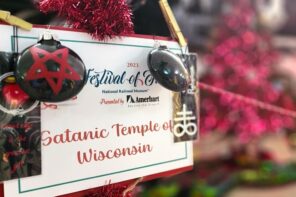A recent federal court ruling cast an unusually sympathetic gaze on Santería, a family of Afro-Caribbean cultural and religious practices that most Americans learn about (or imagine they learn about) through its depiction in unsettling plotlines on crime shows like Law & Order and CSI: Miami.
But in José Merced v. City of Euless, the Court of Appeals for the Fifth Circuit ruled that Merced, a Santería priest in the Dallas-Fort Worth area, was acting within his Constitutional rights when he sacrificed goats and other animals as part of the ritual home-practice that accompanied him from Puerto Rico.
In fact, the court suggested that such Constitutional protections are especially important for “non-traditional” religions like Merced’s.
“There are more than 250,000 practitioners of Santería in the world,” the ruling states, “but only two Santeria temples, neither of which is in the continental United States. Thus, home sacrifice is not only the norm, but a crucial aspect of Santería, without which Santería would effectively cease to exist.”
What else should we understand about Santería? An interview with Salvador Vidal-Ortiz, a sociologist at American University who has studied the roles of gender and sexuality in Santería practices, reveals a tradition “deeply interwoven with discourses of freedom and liberation.”
When did you become interested in studying Santería?
The first drumming event I attended was in 2000. Since then, I’ve attended events where practitioners were being initiated, and annual celebrations of religious birthdays for longtime members. These events have generally taken place in private homes in the Bronx, Brooklyn, and Manhattan; usually in basements prepared as religious sites for ceremony.
What attracted you to the tradition? Did you consider following the practices back to their Caribbean or African roots?
My research focus was here, in the U.S.—not elsewhere—because learning how these practices traveled was as important to me as the practice itself. Unlike Santería practice in other regions of the Western Hemisphere, practice in the U.S. includes people from many ethnic and racial groups. In fact, there are groups here, like Puerto Ricans, who take up forms of the practice more often associated with other groups, like Cubans.
Over the course of my work, I’ve redefined Santería as a religious-cultural practice, and not simply a religion, because of the links between diasporic aspects of African culture (Yoruba traditions in the case of Cuba, and overlapping or altogether different influences in the case of Brazil and other Latin American countries) as well as its syncretism with Catholic influences. I’m also interested in where and why the practice is either hidden or open. For example, even though it was ostracized at its inception when it was practiced by slaves centuries ago, Santería practice is not hidden in contemporary Cuba.
Have you chosen to engage in the practice yourself?
I am quite honest about the scope of my work in terms of “how far I would go” within Santería. I chose not to engage in ritual because I am not a Santero (a practitioner—most people use Santero [m.] or Santera [f.] to refer to initiated practitioners), but there is much more to the practice than its rituals.
What aspect of the practice beyond its rituals has most sustained your interest?
While most people might choose to study a movement like Santería because of their desire to learn about religious practice, I was initially intrigued by the space that I noticed was given to gay and lesbian practitioners. Even though Santería might be perceived as a haven for gays and lesbians in cultures that often provide few other spaces for them—and there are a large number of gay and lesbian practitioners in Santería—the practice itself is deeply interwoven with discourses of freedom and liberation, and power and oppression. This is why the main focus of my work now includes gays and lesbians and women of all sexual orientations.
So what have you learned over the course of your research?
I’ve interviewed women of all sexual orientations and gay and bisexual men who practice Santería. Some are initiated, some are not initiated, and they are from most walks of life. Some people had explored many religions, while others had always been Santería practitioners.
While Santería has opened up a space for gays and lesbians to participate, it has opened up a very different space for gay men than for lesbian women. Gay men are allowed to serve in some roles that are exclusive to men. I agree with Mary Ann Clark (author of Where Men Are Wives and Mothers Rule: Santería Ritual Practices and Their Gender Implications) that this gendered configuration of roles need not be seen as a hierarchy, and instead provokes new ways of thinking by redefining ritual power.
Although only men can become Babalawos (the highest Santería priest position, usually limited to men who are perceived or presumed to be heterosexual), all practitioners become “wives” when they are initiated. As “newborns,” these initiates become the wife of the deity or Orisha that “claimed their head.” This deity will become the focus of the initiate’s worship, and the “wifely” relationship to the deity is the same for all practitioners, regardless of gender.
Can you say more about how the wife-dynamic empowers women and non-heterosexual men?
Ritual possession allows practitioners to experience deity-presence, and everyone benefits when others are possessed, because the possessing Orisha speaks to everyone present at the ritual. Members of a given religious house feel proud whenever there is a lot of deity-presence at one of their events. In possession, a practitioner is “mounted” by the deity—an expression that has obvious gendered and sexual implications, which are generally recognized by practitioners. And, to speak to your question, non-heterosexual men and women of all sexual orientations tend to be possessed more often than their straight counterparts. So their presence is highly valued.
Finally, and more broadly, what do you make of popular notions about Santería in the United States? And what’s your take on recent court decisions that recognize and protect the religiosity of the practice?
Generally speaking, when we are talking about racial and ethnic minorities, the United States’ racial (and racist) system tends to find much of what is non-white “suspicious.” That’s why Santería continues to be categorized as a cult by some, and why the media usually frame practitioners as somehow “criminal” in the coverage we see in the news.
That tendency is mirrored in entertainment media. For at least the past two decades, portrayals of Santería practitioners in movies and television shows have resisted the opportunity to represent them as religious people and focused instead on Santería as a hypersexual space, recalling earlier representations of Africans as savages.
That does seem to be changing, at least incrementally. The recent Texas lawsuit acknowledged the religiosity of the practice: José Merced, a Puerto Rican Santería priest, retained the right of animal sacrifice because the court saw the link to religious freedom. Regardless of how one might feel about animal sacrifice (for consumption or under regulations that maintain public health standards in the handling of food), this religious-cultural practice has ritual elements that one ought to respect, in the very same way most of us respect Judeo-Christian religious practice.
Salvador Vidal-Ortiz is Assistant Professor of Sociology at American University in Washington, DC. Among his recent work is the co-edited special issue of the journal Sexualities: Studies in Culture and Society on the topic of “Retheorizing Homophobias” (with Karl Bryant) and a co-edited book, The Sexuality of Migration: Border Crossings and Mexican Immigrant Men (with Nancy Naples and based on the work by late Lionel Cantú), published by NYU Press.




